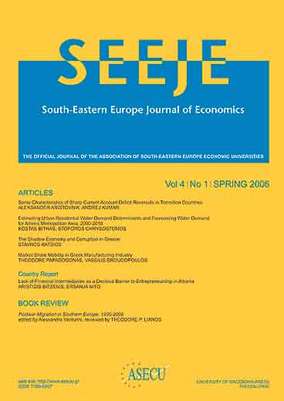Reassessment of sustainability of current account deficit in India
Part of : SEEJE ; Vol.10, No.1, 2012, pages 67-79
Issue:
Pages:
67-79
Author:
Abstract:
In this study, we examined the long-run relationship between oil and non-oil exports and imports, in order to see whether the current account deficit in India is sustainable. To achieve our objective we have carried out cointegration analysis with structural breaks (as unit root analysis of both variables shows that these variables have been subject to structural changes). Interestingly, we found that there is a strong evidence of a long-run relationship between non-oil exports and imports and no evidence in the case of oil exports and imports. This implies that a foreign trade deficit is sustainable in the Indian context for non-oil commodities but not for oil commodities
Subject (LC):
Keywords:
oil and non-oil exports, oil and non-oil imports, unit root, structural breaks, cointegration
Notes:
Περιέχει πίνακες, διαγράμματα, σημειώσεις και βιβλιογραφία, The author wishes to thank two anonymous referees of the journal for their constructive suggestions. Of course, any error that remains is the author’s responsibility. The usual disclaimer applies., JEL Classification: C12, C13, C22, E31, G11
References (1):
- Ahmed S. (1987), Government spending, the balance of trade and the terms of trade in Britishhistory. Journal of Monetary Economics 20: 195–220.Arize, A.C. (2002), Imports and exports in 50 countries: Tests of cointegration and structuralbreaks. International Review of Economics and Finance 11: 101-115.Artis M. J. and Bayoumi T. A. (1989), Saving, investment, financial integration, and the balance ofpayments. IMF Working Paper 89/102, IMF, Washington, DC.Bohn, H. (2007), Are Stationary and Cointegration Restrictions Really Necessary for the TemporalBudget Constraint? Journal of Monetary Economics 54: 1837-1847.Breitung, J. (2002), Nonparametric tests for unit roots and cointegration. Journal of Econometrics108: 343-363.Breitung, J. and Taylor, A.M.R. (2003), Corrigendum to nonparametric tests for unit roots andcointegration. Journal of Econometrics 117: 401-404.Elliott G. and Fatas A. (1996), International business cycles and the dynamics of the currentaccount. European Economic Review 40: 361–87.Erbaykal, E. and Karaca O. (2008), Is Turkey’s foreign deficit sustainable? Cointegrationrelationship between exports and imports. International Research Journal of Finance andEconomics 14: 177-181.Greenidge, K., Archibald, X. and Holder, C. (2006), Debt and fiscal sustainability in Barbados,in Finance and Real Development in the Caribbean (Eds) A. Birchwood and D. Seeranttan,Caribbean Centre for Monetary Studies, University of the West Indies, St. Augustine, pp. 531–45.Greenidge, K., Holder, C. and Moore, A. (2011), Current account deficit sustainability: The case ofBarbados. Applied Economics 43(8): 973-984Hakkio, C., Rush, M. (1991), Is the Budget Deficit Too Large? Economic Inquiry 29, 429–445.Herzer, D. and Nowak-Lehmann D. (2006), Is there a long-run relationship between exports andimports in Chile? Applied Economics Letters 13: 981–986.Holmes, M. J., Panagiotidis, T. and Sharma, A. (2011), The sustainability of India's current account.Applied Economics 43(2): 219 — 229.Husted, S. (1992), The emerging U.S. current account deficit in the 1980s: A cointegration analysis.Review of Economics and Statistics 74: 159-166.Irandoust M, Ericsson J. (2004), Are imports and exports cointegrated? An international comparison.Metroeconomica 55: 49–64.Irandoust M. and Sjöö B. (2000), The behavior of the current account in response to unobservableand observable shock. International Economic Journal 14(4): 41–57.Johansen, S. (1988), Statistical analysis of cointegration vectors. Journal of Economic Dynamicsand Control 12: 231–54.Johansen, S. (1995), Likelihood-Based Inference in Cointegrated Vector Autoregressive Models,Oxford University Press, Oxford.Johansen, S., and K. Juselius (1990), Maximum likelihood estimation and inference on cointegrationwith applications to money demand. Oxford Bulletin of Economics and Statistics 52, 169-210.Johansen, S., Mosconi, R. and Nielsen, B. (2000), Cointegration analysis in the presence ofstructural breaks in the deterministic trend. Econometrics Journal 3: 216–249.Konya, L. and J. P. Singh. (2008), Are Indian Exports and Imports Cointegrated? AppliedEconometrics and International Development 8: 177-186.Lanne, M., Lütkepohl, H. and Saikkonen, P. (2001), Test procedures for unit roots in time serieswith level shifts at unknown time. Discussion paper, Humboldt-Universit¨at Berlin.Lanne, M., Lütkepohl, H. and Saikkonen, P. (2002), Comparison of unit root tests for time serieswith level shifts. Journal of Time Series Analysis 27: 663-685.Razin A. (1995), The dynamic optimizing approach to the current account: Theory and evidence,in Kenen P. B. (ed.): Understanding Interdependence: The Macroeconomics of the OpenEconomy, Princeton University Press, Princeton, NJ.Sachs J. D. (1981), The current account and macroeconomic adjustment in the 1970s. BrookingsPapers on Economic Activity 1: 201–68.Saikkonen, P. and Lütkepohl, H. (2000a), Testing for the cointegrating rank of a VAR process withan intercept. Econometric Theory 16(3): 373-406.Saikkonen, P. and Lütkepohl, H. (2000b), Testing for the cointegrating rank of a VAR process withstructural shifts. Journal of Business and Economic Statistics 18(4): 451-464.Saikkonen, P. and Lütkepohl, H. (2000c), Trend adjustment prior to testing for the cointegratingrank of a vector autoregressive process. Journal of Time Series Analysis 21: 435-456.Saikkonen, P. and Lütkepohl, H. (2002), Testing for a unit root in a time series with a level shift atunknown time. Econometric Theory 18: 313–348.Sharma, A., & Panagiotidis, T. (2005), An analysis of exports and growth in India: Some EmpiricalEvidence. Review of Development Economics 9(2): 232-248.Summers, L. H. (1988), Tax policy and international competitiveness, in Frenkel J. A. (ed.),International Aspects of Fiscal Policies, University of Chicago Press, Chicago, IL.Tiwari, Aviral K. (2011), Are Exports and imports cointegrated in India and China? An empiricalanalysis. Economics Bulletin 31(1): 860-873.Tiwari, Aviral K. and Pandey, B. (2011), Is trade deficit sustainable in India? An inquiry. TheEmpirical Economics Letters 10(9): 843-850.Upender, M. (2007), Long run equilibrium between India’s exports and imports during 1949-502004-05.Applied Econometrics and International Development 7: 187-196.




